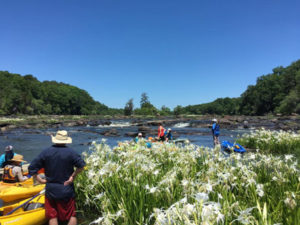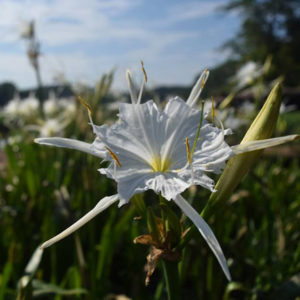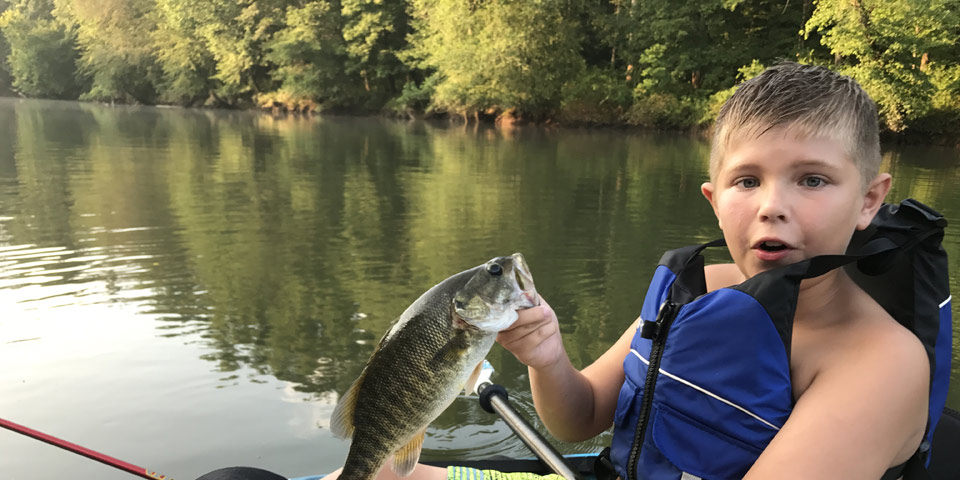The River
Access & RecreationWith a diverse and pristine riverine environment
the Flint River offers a tremendous range of outdoor experiences throughout its length.
 Thanks to efforts by then-govenor, Jimmy Carter and others to block a dam at Sprewell Bluff in the 70s, the Upper Piedmont area through the fall line shoals is arguably the most scenic stretch of river in the state. The 50-mile stretch can be broken into several smaller segments that offer enjoyable paddling for any skill level. The river alternates between wide gentle flow and swifter rapids through this area. Most of the rapids through this area are considered Class I-II but the Yellow Jacket Shoals offer some Class III-IV play for the more experienced paddler.
Thanks to efforts by then-govenor, Jimmy Carter and others to block a dam at Sprewell Bluff in the 70s, the Upper Piedmont area through the fall line shoals is arguably the most scenic stretch of river in the state. The 50-mile stretch can be broken into several smaller segments that offer enjoyable paddling for any skill level. The river alternates between wide gentle flow and swifter rapids through this area. Most of the rapids through this area are considered Class I-II but the Yellow Jacket Shoals offer some Class III-IV play for the more experienced paddler.
The middle section of the Flint leading to Lake Blackshear changes to a broad and deep river; following a sandy, sediment-based channel that transitions easily with heavy flows. This frequent shift in the sandy banks results in large sand bars perfect for camping, picnicking and fishing. Lake Blackshear is the first of three impoundments on the Flint. It is a long, somewhat shallow lake providing good boating and fishing opportunities.
 After leaving Lake Blackshear, the river gradually transitions to a hard limestone terrain with dramatic cliffs along the shoreline. This stretch of river is known for the its cold and crystal clear blue springs, frequented by locals for a refreshing summer swim. Limestone shoals in this section of river create an environment that supports the Shoal Bass and many other fauna that help make the Flint home to one of the most diverse ecosystems in the region. The Shoal Bass are indigenous to the Flint River and can be found in shoal areas throughout the river system. Fishermen have long revered the Flint River for the opportunity to snag one of these elusive fish and for its natural beauty and abundance of other fish and wildlife.
After leaving Lake Blackshear, the river gradually transitions to a hard limestone terrain with dramatic cliffs along the shoreline. This stretch of river is known for the its cold and crystal clear blue springs, frequented by locals for a refreshing summer swim. Limestone shoals in this section of river create an environment that supports the Shoal Bass and many other fauna that help make the Flint home to one of the most diverse ecosystems in the region. The Shoal Bass are indigenous to the Flint River and can be found in shoal areas throughout the river system. Fishermen have long revered the Flint River for the opportunity to snag one of these elusive fish and for its natural beauty and abundance of other fish and wildlife.
The river is easily accessed at numerous spots throughout its length. For more information on paddling fishing and hiking opportunities on the Flint, look for Fred Brown’s book, The Flint River: A Recreational Guidebook to the Flint River and Environs (Atlanta: CI Publications, 2001) or visit http://www.sherpaguides.com/georgia/flint_river/index.html for information in the Sherpa Guides’ The Natural Georgia Series: The Flint River.
The Flint River needs YOU! And so does FRk.
Get involved today by visiting our Membership page and joining the FRk to start receiving information about our efforts to protect this vital resource for our region.
Connect with FRk on Social Media!

